This was published 1 year ago
Escape the crowds in Venice by staying on a city island
By Lee Tulloch
The city of Venice sits delicately on an archipelago of 118 islands, most of them linked by narrow canals and centuries-old bridges.
In the heat of summer, Venetians head for the Lido, the 11-kilometre strip of beach in the lagoon. For their vegetables, they sometimes take a boat to Sant’Erasmo, the garden island. They buy their glasswear on Murano and bury their dead on the island of San Michele, the cemetery where visitors can find the graves of Ezra Pound and Igor Stravinsky.
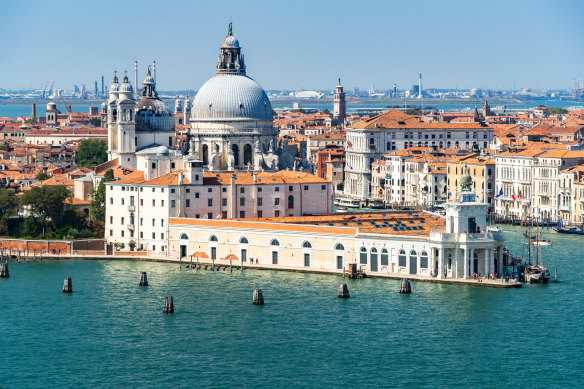
Giudecca is a traditionally working-class island.Credit: iStock
Apart from visiting the linked islands of Murano and the lace-making centre of Burano, travellers to Venice usually have little time to spend exploring Venice’s beautiful, historic islands, even though many are only a short ride away on the public water ferries, the vaporetto.
But there’s a unique way to get a taste of island life, Venetian style, and that is to sleep on one.
In recent years I’ve stayed across the lagoon on Giudecca, the traditionally working-class island that has superb views of Piazza San Marco from its long waterfront promenade. It’s part of the siestre or district of Dorsoduro but it’s a 10-minute vaporetto ride from the crowded tourist streets and feels a million miles away.
It’s bookmarked by the Hilton Molino Stucky on one end, which is an impressive renovation of a historic flour mill, and the Belmond Cipriani, one of Italy’s finest hotels, at the other. I’ve stayed at both, and always loved taking either the vaporetto or the hotels’ small speedboats into San Marco, knowing that it’s only a short ride back to sanity when the crowds get too much.
On my latest trip this European summer, I discovered two hotels that occupy entire islands, shared only with your fellow guests. The JW Marriott Venice Resort & Spa and the San Clemente Palace Kempinski both sit outside the lagoon about 15 minutes from the Doge’s Palace. I didn’t know when I made my reservations that they are only a few minutes apart by speedboat.
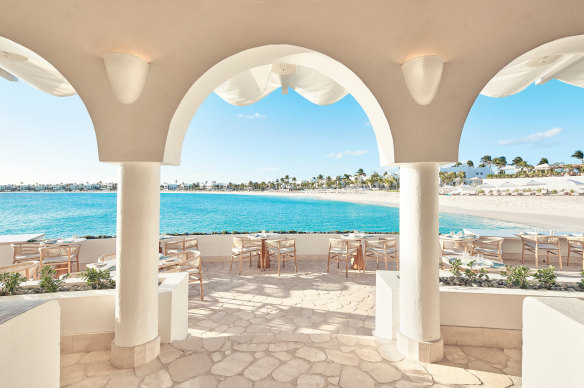
Belmond Cipriani, Venice: one of Italy’s finest.
It’s very hot in Venice in August and I’ve been staying right in the centre, so when the JW Marriott shuttle speedboat powers into its dedicated dock in front of the gardens near San Marco, I’m more than ready to get away from the throng and the humidity. I’ve had to drag my luggage from my nearby hotel, up and down the marble steps of a bridge, and the water taxi drivers won’t share their seat in the shade with me.
But once we’re on the water all is forgotten. The ride is scenic, speeding past the island of San Giorgio Maggiore, and the cemetery island San Michele with its high walls. There are other scattered islands, many of which look deserted. Perhaps these are some of the quarantine islands that were set up when the plague hit Venice in medieval times.
The real name of the island the JW Marriott occupies is Sacca Sessola, but these days it has the prettier name of Isola Delle Rose, for the rose garden in the middle of the 16-hectare property. From 1914 to the 1950s it was a rehabilitation hospital for tuberculosis patients and incorporates the original buildings in its plan, with the addition of conference centre, a grand spa with a vitality pool, and new apartment wings and maisonettes, making 250 rooms and suites in total.
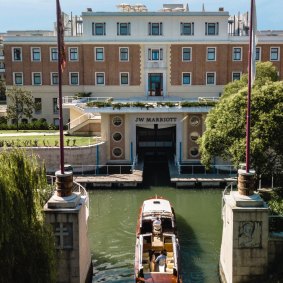
Arriving at the JW Marriott Venice Resort & Spa.
Like most hospitals, it has beautiful gardens and the large established trees have been preserved and tagged. It’s surrounded by water and the only part not accessible is a wildly grassed corner, which will be turned into a solar farm to produce most of the island’s energy.
There are views of the belltower of Piazza San Marco from the precisely manicured green lawns that surround the outdoor tables of the casual Cucina restaurant, and breathtaking 360-degree view of the whole lagoon from the rooftop, which includes a sunset bar, the Sagra Rooftop Restaurant and pizzeria, and a sensational adults-only infinity pool right on its edge.
I’m in room 347 which is in the old hospital, and it has a large terrace balcony, perfect for recuperating from Venice. On the day I arrive, there’s a wedding and the hotel is full of glamorously dressed people, who party into the night at the 1930s Byzantine-style church on the property and their rather loud music fills the warm air (along with mosquitos). The hotel is popular for events, and it recently hosted a Pakistani wedding where a white horse was brought from Milan for the occasion.
While it’s not the refuge I expected, there are parts of the island where I see nobody. I love the quiet lanes that are lined with the ancient, twisted olive trees that produce the hotel’s oil. There’s a formal garden, a kitchen garden with greenhouses, and an orchard (where I can’t resist stealing a ripe fig.)
It’s all maintained immaculately and there’s everything you might desire from a sophisticated resort – free bicycles, picnic rugs and baskets, a kid’s club and pool, and cooking classes with the charming Alessio, who teaches me to make arancini and Napoli-style fried pizza. It’s ideal if you want to keep the children entertained between forays into the city.
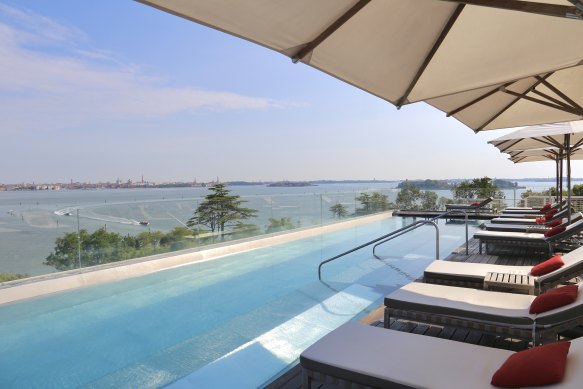
A different blue - pool at the JW Marriott Venice Resort & Spa.
After two nights, it’s time to move to the neighbouring island by taking the JW Marriott transfer back to San Marco and walking a few metres along the dock to where the San Clemente Palace Kempinski transfer picks up guests. Both resorts run complimentary transfers every 30-40 minutes, from morning until late at night, so it’s easy to go back and forth two or three times a day if you wish.
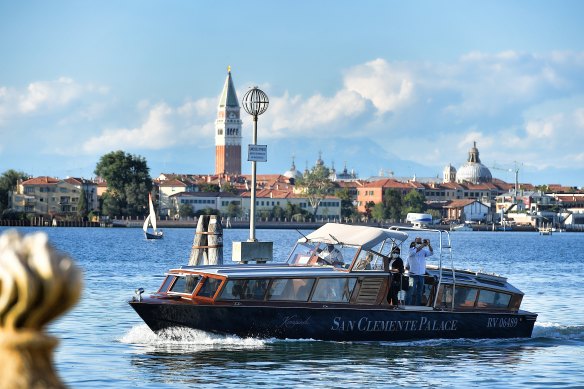
The hotels run complimentary water taxi services.
The Kempinski hotel has a completely different vibe. Many hotels claim to be a sanctuary, but this is a true one, historically at least. The island’s buildings date back to the 12th century when it was a hospice for soldiers and pilgrims travelling from the Holy Lands. In the 14th century Pope Eugene IV moved an order of monks there and a monastery was established. In the Napoleonic era it became a hospital and later a psychiatric institute. It has been a hotel for 20 years.
The first building I see from the dock is the Church of San Clemente, a Romanesque church dating to 1131 which contains the relics of Saint Arianus. Much of the island is walled with beautiful gates. The hotel building itself has the grandeur of a monastery, with ceilings in the 196 rooms and suites over four metres high and wide, long corridors that go forever, arranged around two courtyards. The floors are the original polished terrazzo, and the walls are covered in silk.
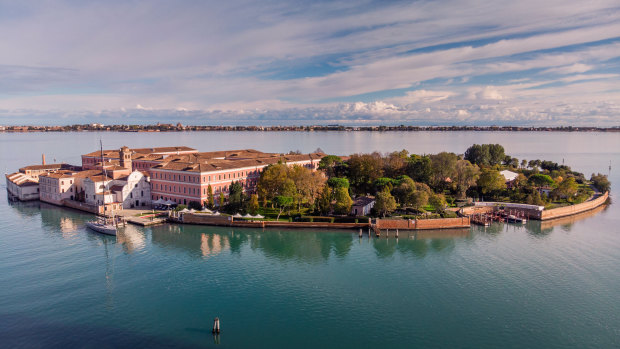
San Clemente Palace Kempinski: a true sanctuary.
Much of the furniture is centuries old, but it doesn’t feel like a museum. The hotel’s president, Selim Uyar, is a passionate collector of contemporary art and the corridors and seven hectares of gardens are full of paintings, large-scale sculptures and whimsical installations like giant glass eyes that peep out from the bushes.
The hotel collaborates with the Venice Biennale and currently showcases South Korean artist Seung-Hwan Kim’s enormous, twisted silver organisms.
Berengo, the glass factory on Murano that works with artists such as Ai Weiwei and some of those on display at San Clemente Palace, will collect guests by water taxi for a complimentary visit of its furnace and gallery, an excursion that is well worth doing.
The resort respects the original topography of the island, keeping its small hills, which have seats and pergolas for taking in the lagoon view. The garden is planted with well established linden, cypress, elm, olive and palm trees.
There’s a heated, 21.5 metre outdoor swimming pool, a tennis court, indoor and garden gyms, running track, putting course, an outdoor cinema and The Merchant of Venice Spa, which offers facials using 24-carat gold leaf. Dozens of brilliantly feathered pheasants scratch about on the lawns.
People come from Venice to dine at the al fresco Acquerello Restaurant, under market umbrellas outside the church. There are regular concerts in the chapel.
The glamorous Clemente bar extends outdoors along the lagoon with comfortable sofas. I spent hours here during the long, summer sunsets, watching the speedboats zoom by.
The signature cocktail of the Clemente bar is the Chaos, created by bar tender Walter, who supervised the bar on the Venice Simplon Orient Express for many years. It’s a strange name for a drink because this serene and unique property feels about as far from the chaos of Venice as you can get, even though that’s only 15 minutes away.
The writer was a guest of JW Marriott Venice Resort & Spa and San Clemente Palace Kempinski
THE DETAILS
STAY
JW Marriott Venice Resort & Spa is open March-November, rooms from €450 ($745). See marriott.com
San Clemente Palace Kempinski is open March-November, rooms from €600. See kempinski.com
RIDE
Venice’s public transport system is the Vaporetto or water taxi which crisscrosses the lagoons and canals, and the Alilaguna, which is a network of five lines that takes travellers to islands further afield as well as the airport. Individual Vaporetto tickets for one ride cost €9, so it makes sense if you’re staying longer than a day to buy a Venezia Unica City Pass, which can be bought at certain water taxi stations. There are online offers of reduced rates if you book in advance.
Sign up for the Traveller Deals newsletter
Get exclusive travel deals delivered straight to your inbox. Sign up now.